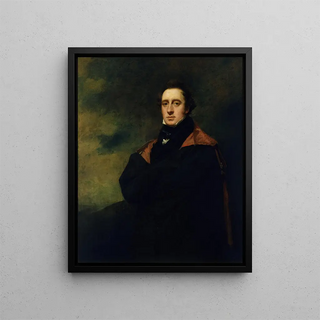Art print | Andrew Spottiswoode 1787-1866 - Sir Henry Raeburn Source: Reproduction | Andrew Spottiswoode 1787-1866 - Sir Henry Raeburn


View from behind

Frame (optional)
In the vast panorama of 19th-century British art, the art print "Andrew Spottiswoode 1787-1866 - Sir Henry Raeburn" stands out for its elegance and psychological depth. This portrait, executed by the Scottish master Sir Henry Raeburn, offers a fascinating glimpse into the world of the bourgeoisie of the time. Through the intense gaze and confident posture of Andrew Spottiswoode, the viewer is invited to explore the subtleties of a man who left his mark on his era. The lighting, skillfully orchestrated, highlights the subject's features, while the dark and nuanced background creates an atmosphere conducive to contemplation. This painting does not merely freeze a moment; it tells a story, that of a man and a period.
Style and uniqueness of the work
Sir Henry Raeburn's style is characterized by an exceptional mastery of portraiture, where every detail is carefully considered to reinforce the identity of the subject. In this work, the chiaroscuro technique is emphasized, creating a striking contrast between shadows and lights. Andrew Spottiswoode's richly textured clothing reveals the artist's virtuosity in rendering materials. The folds of the fabric seem almost tangible, while the face of the subject, imbued with dignity, exudes a disturbing serenity. Raeburn has this unique ability to capture not only the external appearance but also the psychology of his models, making each portrait lively and timeless. This work perfectly illustrates the artist's ability to transcend mere style exercise to offer a true emotional experience.
The artist and his influence
Sir Henry Raeburn, born in 1756 in Edinburgh, is an iconic figure of Scottish portraiture. His work profoundly influenced British painting, marking a transition towards a more modern and personal style. Raeburn managed to establish himself in an artistic environment dominated by rigid traditions, by bringing a more humanist and intimate approach. His portraits, often commissioned by the bourgeoisie and aristocracy, testify to a period

Matte finish

View from behind

Frame (optional)
In the vast panorama of 19th-century British art, the art print "Andrew Spottiswoode 1787-1866 - Sir Henry Raeburn" stands out for its elegance and psychological depth. This portrait, executed by the Scottish master Sir Henry Raeburn, offers a fascinating glimpse into the world of the bourgeoisie of the time. Through the intense gaze and confident posture of Andrew Spottiswoode, the viewer is invited to explore the subtleties of a man who left his mark on his era. The lighting, skillfully orchestrated, highlights the subject's features, while the dark and nuanced background creates an atmosphere conducive to contemplation. This painting does not merely freeze a moment; it tells a story, that of a man and a period.
Style and uniqueness of the work
Sir Henry Raeburn's style is characterized by an exceptional mastery of portraiture, where every detail is carefully considered to reinforce the identity of the subject. In this work, the chiaroscuro technique is emphasized, creating a striking contrast between shadows and lights. Andrew Spottiswoode's richly textured clothing reveals the artist's virtuosity in rendering materials. The folds of the fabric seem almost tangible, while the face of the subject, imbued with dignity, exudes a disturbing serenity. Raeburn has this unique ability to capture not only the external appearance but also the psychology of his models, making each portrait lively and timeless. This work perfectly illustrates the artist's ability to transcend mere style exercise to offer a true emotional experience.
The artist and his influence
Sir Henry Raeburn, born in 1756 in Edinburgh, is an iconic figure of Scottish portraiture. His work profoundly influenced British painting, marking a transition towards a more modern and personal style. Raeburn managed to establish himself in an artistic environment dominated by rigid traditions, by bringing a more humanist and intimate approach. His portraits, often commissioned by the bourgeoisie and aristocracy, testify to a period






